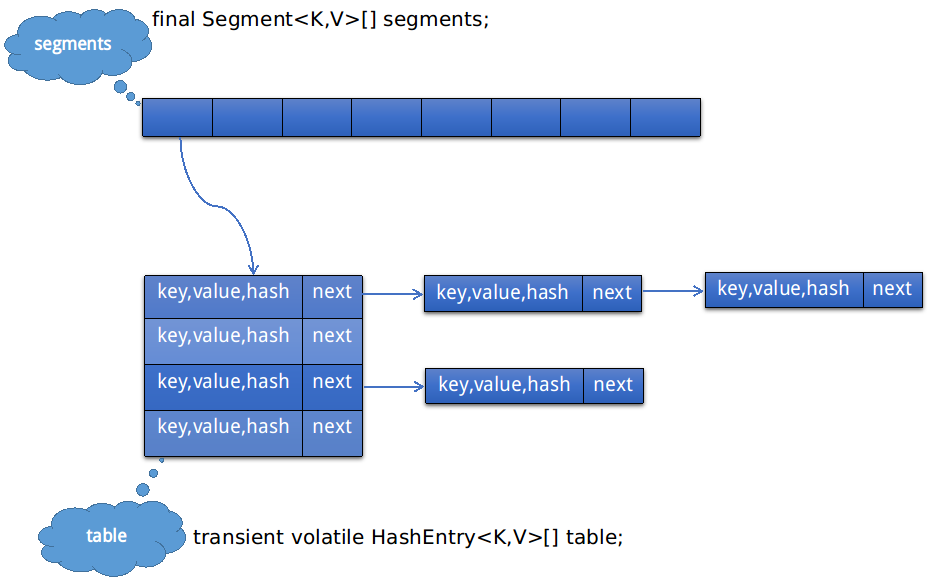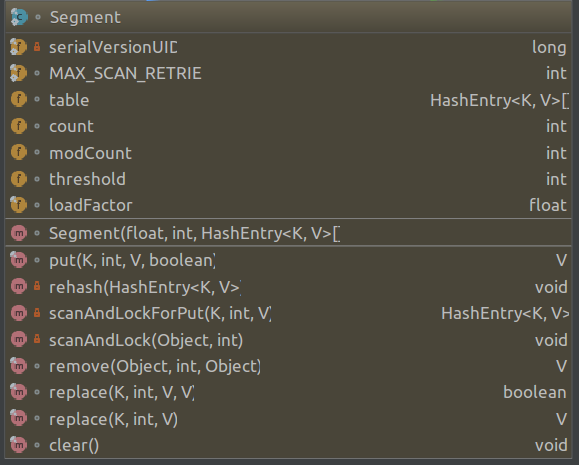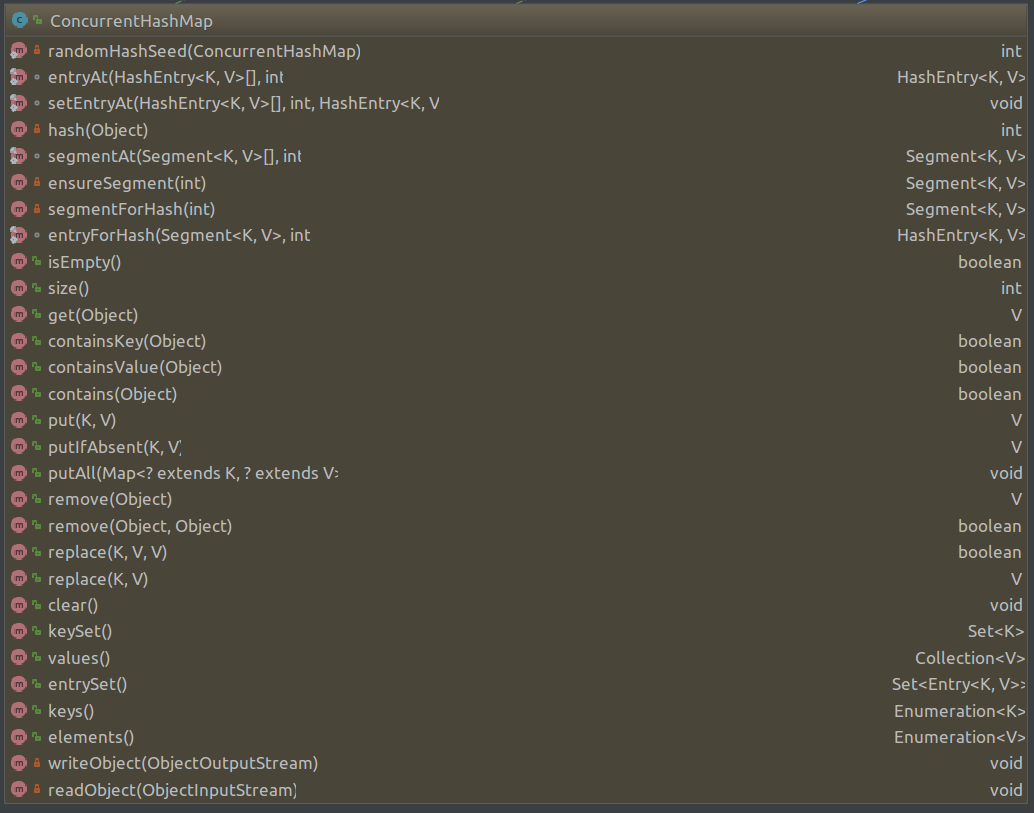ConcurrentHashMap代码解析
ConcurrentHashMap (JDK 1.7)的继承关系如下:

1. ConcurrentHashMap是线程安全的hash map。ConcurrentHashMap的数据结构是一个Segment<K, V>数组:
/**
* The segments, each of which is a specialized hash table.
*/
final Segment<K,V>[] segments;
Segment数组segments的每一个元素都包含一个HashEntry<K, V>数组table,这个table类似于HashMap中的table。因此ConcurrentHashMap的存储结构其实是两层,通过两次hash来定位元素所在的链表,图示结构如下:

其中,HashEntry的定义如下:
/**
* ConcurrentHashMap list entry. Note that this is never exported
* out as a user-visible Map.Entry.
*/
static final class HashEntry<K,V> {
final int hash;
final K key;
volatile V value;
volatile HashEntry<K,V> next;
}
因此,Segment数组的意义就是将一个大的table分割成多个小的table来进行加锁(即,锁分离技术),而每一个Segment元素存储的是HashEntry数组+链表,和HashMap的数据存储结构一样。
2. Segment是静态static final类,
static final class Segment<K,V> extends ReentrantLock implements Serializable {}
他有自己的成员变量和方法:

成员变量:
table: 表示每个segment的数组
count: 表示元素个数
modCount: 表示table被修改的次数
threshold: 表示table需要扩容的阈值
loadFactor: 表示table的负载因子,超过负载因子之后table会扩容
方法:
Segment继承了ReentrantLock类,所以他自带锁功能,在其方法中可以体现出来。
a. put()方法
final V put(K key, int hash, V value, boolean onlyIfAbsent) {
HashEntry<K,V> node = tryLock() ? null :
scanAndLockForPut(key, hash, value);
V oldValue;
try {
HashEntry<K,V>[] tab = table;
int index = (tab.length - 1) & hash;
//
HashEntry<K,V> first = entryAt(tab, index);
for (HashEntry<K,V> e = first;;) {
if (e != null) {
K k;
if ((k = e.key) == key ||
(e.hash == hash && key.equals(k))) {
oldValue = e.value;
if (!onlyIfAbsent) {
e.value = value;
++modCount;
}
break;
}
e = e.next;
}
else {
if (node != null)
node.setNext(first);
else
node = new HashEntry<K,V>(hash, key, value, first);
int c = count + 1;
if (c > threshold && tab.length < MAXIMUM_CAPACITY)
rehash(node);
else
setEntryAt(tab, index, node);
++modCount;
count = c;
oldValue = null;
break;
}
}
} finally {
unlock();
}
return oldValue;
}
b. rehash()方法
/**
* Doubles size of table and repacks entries, also adding the
* given node to new table
*/
@SuppressWarnings("unchecked")
private void rehash(HashEntry<K,V> node) {
/*
* Reclassify nodes in each list to new table. Because we
* are using power-of-two expansion, the elements from
* each bin must either stay at same index, or move with a
* power of two offset. We eliminate unnecessary node
* creation by catching cases where old nodes can be
* reused because their next fields won't change.
* Statistically, at the default threshold, only about
* one-sixth of them need cloning when a table
* doubles. The nodes they replace will be garbage
* collectable as soon as they are no longer referenced by
* any reader thread that may be in the midst of
* concurrently traversing table. Entry accesses use plain
* array indexing because they are followed by volatile
* table write.
*/
HashEntry<K,V>[] oldTable = table;
int oldCapacity = oldTable.length;
int newCapacity = oldCapacity << 1;
threshold = (int)(newCapacity * loadFactor);
HashEntry<K,V>[] newTable =
(HashEntry<K,V>[]) new HashEntry[newCapacity];
int sizeMask = newCapacity - 1;
for (int i = 0; i < oldCapacity ; i++) {
HashEntry<K,V> e = oldTable[i];
if (e != null) {
HashEntry<K,V> next = e.next;
int idx = e.hash & sizeMask;
if (next == null) // Single node on list
newTable[idx] = e;
else { // Reuse consecutive sequence at same slot
HashEntry<K,V> lastRun = e;
int lastIdx = idx;
for (HashEntry<K,V> last = next;
last != null;
last = last.next) {
int k = last.hash & sizeMask;
if (k != lastIdx) {
lastIdx = k;
lastRun = last;
}
}
newTable[lastIdx] = lastRun;
// Clone remaining nodes
for (HashEntry<K,V> p = e; p != lastRun; p = p.next) {
V v = p.value;
int h = p.hash;
int k = h & sizeMask;
HashEntry<K,V> n = newTable[k];
newTable[k] = new HashEntry<K,V>(h, p.key, v, n);
}
}
}
}
int nodeIndex = node.hash & sizeMask; // add the new node
node.setNext(newTable[nodeIndex]);
newTable[nodeIndex] = node;
table = newTable;
}
这些都是Segment类自己的方法,不是ConcurrentHashMap()的方法。
3. ConcurrentHashMap同样会有的自己的put() / get() / remove()等方法,是在Segment类的方法上实现的。

ConcurrentHashMap默认构造函数为:
/**
* Creates a new, empty map with a default initial capacity (16),
* load factor (0.75) and concurrencyLevel (16).
*/
public ConcurrentHashMap() {
this(DEFAULT_INITIAL_CAPACITY, DEFAULT_LOAD_FACTOR, DEFAULT_CONCURRENCY_LEVEL);
}
this有3个参数:
a. DEFAULT_INITIAL_CAPACITY,表示table的默认大小
/**
* The default initial capacity for this table,
* used when not otherwise specified in a constructor.
*/
static final int DEFAULT_INITIAL_CAPACITY = 16;
b. DEFAULT_LOAD_FACTOR,表示table的负载因子
/**
* The default load factor for this table, used when not
* otherwise specified in a constructor.
*/
static final float DEFAULT_LOAD_FACTOR = 0.75f;
c. DEFAULT_CONCURRENCY_LEVEL,表示table默认的并发度,也就是segments数组的大小!!
/**
* The default concurrency level for this table, used when not
* otherwise specified in a constructor.
*/
static final int DEFAULT_CONCURRENCY_LEVEL = 16;
this调用了:
/**
* Creates a new, empty map with the specified initial
* capacity, load factor and concurrency level.
*
* @param initialCapacity the initial capacity. The implementation
* performs internal sizing to accommodate this many elements.
* @param loadFactor the load factor threshold, used to control resizing.
* Resizing may be performed when the average number of elements per
* bin exceeds this threshold.
* @param concurrencyLevel the estimated number of concurrently
* updating threads. The implementation performs internal sizing
* to try to accommodate this many threads.
* @throws IllegalArgumentException if the initial capacity is
* negative or the load factor or concurrencyLevel are
* nonpositive.
*/
@SuppressWarnings("unchecked")
public ConcurrentHashMap(int initialCapacity,
float loadFactor, int concurrencyLevel) {
if (!(loadFactor > 0) || initialCapacity < 0 || concurrencyLevel <= 0)
throw new IllegalArgumentException();
if (concurrencyLevel > MAX_SEGMENTS)
concurrencyLevel = MAX_SEGMENTS;
// Find power-of-two sizes best matching arguments、
// 寻找大于等于concurrencyLevel的一个整数ssize,这个整数是2的倍数,默认值应该是16
int sshift = 0;
int ssize = 1;
while (ssize < concurrencyLevel) {
++sshift;
ssize <<= 1;
}
this.segmentShift = 32 - sshift;
this.segmentMask = ssize - 1;
// initialCapacity的默认是是table数组的大小(默认为16)
if (initialCapacity > MAXIMUM_CAPACITY)
initialCapacity = MAXIMUM_CAPACITY;
// c默认值是16 / 16 = 1
int c = initialCapacity / ssize;
if (c * ssize < initialCapacity)
++c;
// MIN_SEGMENT_TABLE_CAPACITY表示每个segment中table的最小容量(默认为2)
int cap = MIN_SEGMENT_TABLE_CAPACITY;
while (cap < c)
cap <<= 1;
// create segments and segments[0]
Segment<K,V> s0 = new Segment<K,V>(loadFactor, (int)(cap * loadFactor), (HashEntry<K,V>[])new HashEntry[cap]);
Segment<K,V>[] ss = (Segment<K,V>[])new Segment[ssize];
UNSAFE.putOrderedObject(ss, SBASE, s0); // ordered write of segments[0]
this.segments = ss;
}
ConcurrentHashMap的put()方法:
/**
* Maps the specified key to the specified value in this table.
* Neither the key nor the value can be null.
*
* <p> The value can be retrieved by calling the <tt>get</tt> method
* with a key that is equal to the original key.
*
* @param key key with which the specified value is to be associated
* @param value value to be associated with the specified key
* @return the previous value associated with <tt>key</tt>, or
* <tt>null</tt> if there was no mapping for <tt>key</tt>
* @throws NullPointerException if the specified key or value is null
*/
@SuppressWarnings("unchecked")
public V put(K key, V value) {
Segment<K,V> s;
if (value == null)
throw new NullPointerException();
// 此处的hash()方法是属于ConcurrentHashMap类,Segment的put()方法使用的hash方式是(table.length - 1) & hash,这个hash值是调用的ConcurrentHashMap的hash()方法产生的
int hash = hash(key);
// j表示segment的索引
int j = (hash >>> segmentShift) & segmentMask;
if ((s = (Segment<K,V>)UNSAFE.getObject // nonvolatile; recheck
(segments, (j << SSHIFT) + SBASE)) == null) // in ensureSegment
// 获取第j个segment
s = ensureSegment(j);
// 这里的put()方法是Segment的方法
return s.put(key, hash, value, false);
}
get()方法
/**
* Returns the value to which the specified key is mapped,
* or {@code null} if this map contains no mapping for the key.
*
* <p>More formally, if this map contains a mapping from a key
* {@code k} to a value {@code v} such that {@code key.equals(k)},
* then this method returns {@code v}; otherwise it returns
* {@code null}. (There can be at most one such mapping.)
*
* @throws NullPointerException if the specified key is null
*/
public V get(Object key) {
Segment<K,V> s; // manually integrate access methods to reduce overhead
HashEntry<K,V>[] tab;
int h = hash(key);
long u = (((h >>> segmentShift) & segmentMask) << SSHIFT) + SBASE;
if ((s = (Segment<K,V>)UNSAFE.getObjectVolatile(segments, u)) != null &&
(tab = s.table) != null) {
for (HashEntry<K,V> e = (HashEntry<K,V>) UNSAFE.getObjectVolatile
(tab, ((long)(((tab.length - 1) & h)) << TSHIFT) + TBASE);
e != null; e = e.next) {
K k;
if ((k = e.key) == key || (e.hash == h && key.equals(k)))
return e.value;
}
}
return null;
}
remove()方法
/**
* Removes the key (and its corresponding value) from this map.
* This method does nothing if the key is not in the map.
*
* @param key the key that needs to be removed
* @return the previous value associated with <tt>key</tt>, or
* <tt>null</tt> if there was no mapping for <tt>key</tt>
* @throws NullPointerException if the specified key is null
*/
public V remove(Object key) {
int hash = hash(key);
Segment<K,V> s = segmentForHash(hash);
return s == null ? null : s.remove(key, hash, null);
}
segmentForHash()方法,通过hash值获取相应segment
/**
* Get the segment for the given hash
*/
@SuppressWarnings("unchecked")
private Segment<K,V> segmentForHash(int h) {
long u = (((h >>> segmentShift) & segmentMask) << SSHIFT) + SBASE;
return (Segment<K,V>) UNSAFE.getObjectVolatile(segments, u);
}
ConcurrentHashMap代码解析的更多相关文章
- Java7/8 中的 HashMap 和 ConcurrentHashMap 全解析
Java7/8 中的 HashMap 和 ConcurrentHashMap 全解析 今天发一篇”水文”,可能很多读者都会表示不理解,不过我想把它作为并发序列文章中不可缺少的一块来介绍.本来以为花不了 ...
- Java并发指南13:Java7/8 中的 HashMap 和 ConcurrentHashMap 全解析
Java7/8 中的 HashMap 和 ConcurrentHashMap 全解析 转自https://www.javadoop.com/post/hashmap#toc7 部分内容转自 http: ...
- VBA常用代码解析
031 删除工作表中的空行 如果需要删除工作表中所有的空行,可以使用下面的代码. Sub DelBlankRow() DimrRow As Long DimLRow As Long Dimi As L ...
- [nRF51822] 12、基础实验代码解析大全 · 实验19 - PWM
一.PWM概述: PWM(Pulse Width Modulation):脉冲宽度调制技术,通过对一系列脉冲的宽度进行调制,来等效地获得所需要波形. PWM 的几个基本概念: 1) 占空比:占空比是指 ...
- [nRF51822] 11、基础实验代码解析大全 · 实验16 - 内部FLASH读写
一.实验内容: 通过串口发送单个字符到NRF51822,NRF51822 接收到字符后将其写入到FLASH 的最后一页,之后将其读出并通过串口打印出数据. 二.nRF51822芯片内部flash知识 ...
- [nRF51822] 10、基础实验代码解析大全 · 实验15 - RTC
一.实验内容: 配置NRF51822 的RTC0 的TICK 频率为8Hz,COMPARE0 匹配事件触发周期为3 秒,并使能了TICK 和COMPARE0 中断. TICK 中断中驱动指示灯D1 翻 ...
- [nRF51822] 9、基础实验代码解析大全 · 实验12 - ADC
一.本实验ADC 配置 分辨率:10 位. 输入通道:5,即使用输入通道AIN5 检测电位器的电压. ADC 基准电压:1.2V. 二.NRF51822 ADC 管脚分布 NRF51822 的ADC ...
- java集合框架之java HashMap代码解析
java集合框架之java HashMap代码解析 文章Java集合框架综述后,具体集合类的代码,首先以既熟悉又陌生的HashMap开始. 源自http://www.codeceo.com/arti ...
- 【转】ConcurrentHashMap完全解析(JDK6/7、JDK8)
转自http://my.oschina.net/hosee/blog/675884 并发编程实践中,ConcurrentHashMap是一个经常被使用的数据结构,相比于Hashtable以及Colle ...
随机推荐
- 使用json web token
由来 做了这么长时间的web开发,从JAVA EE中的jsf,spring,hibernate框架,到spring web MVC,到用php框架thinkPHP,到现在的nodejs,我自己的看法是 ...
- List集合remove元素的问题
import java.util.*; public class object { public static void main(String[] args) { String str1 = new ...
- Painting the Fence Gym - 101911E(构造)
There is a beautiful fence near Monocarp's house. The fence consists of nn planks numbered from left ...
- ecplise打不开提示Eclipse中...No java virtual machine was found...
解决办法: 在eclipse.ini文件中最前面添加这两行: -vm C:\Program Files\Java\jdk1.8.0_191\bin\javaw.exe 上面那个路径是你的java jd ...
- Tomcat v9.0 Could not publish to the server. java.lang.IndexOutOfBoundsException
今天使用Tomcat启动一个java项目,出现报错: Could not publish to the server. java.lang.IndexOutOfBoundsException 众寻之下 ...
- RFC2616-HTTP1.1-Status Code(状态码规定部分—单词注释版)
part of Hypertext Transfer Protocol -- HTTP/1.1RFC 2616 Fielding, et al. 10 Status Code Definitions ...
- React + antd 组件离开页面以后出现Can only update a mounted or mounting component 的解决办法
做项目的过程中,来回切换页面时,一直遇到Can only update a mounted or mounting component 这个问题,原因是当离开页面以后,组件已经被卸载,执行setSta ...
- antd + node.js + mongoose小总结
最近开发太忙,都没时间更新博客,想通过这篇博客总结一下相关经验,以备后续能用到: 一.antd 1.onChange of undefined问题:可能是页面中表单取了相同的名称,也可能是在遍历时表单 ...
- Django基础(四)
Django-4 知识预览 分页器(paginator) COOKIE 与 SESSION Django的用户认证 FORM 回到顶部 分页器(paginator) 分页器的使用 1 2 3 4 5 ...
- Git 基本命令行操作
一.本地仓库操作 1.初始化 git init 2.添加版本控制文件 git add README.md3.本地提交 git commit -m “1st commit”4.配置远程 ...
